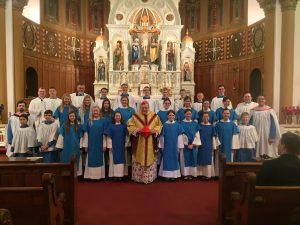Over the weekend I attended the second annual Prairie Troubadour symposium in Fr. Scott, KS, on the topic of The Restoration of the Imagination. The conference included a great line-up of speakers including Christopher Check, Dale Alquist and Anthony Esolen (among others) and finished with an evening of cigars and whiskey with the speakers and a host of great old friends (and now some new ones). As Belloc once wrote, “Wherever the Catholic sun doth shine, There’s always laughter and good red wine. At least I’ve always found it so. Benedicamus Domino!” How delightfully true!
With the symposium fresh on my mind, I thought today I would take up the topic of the imagination again and its relation to sacred music, especially since most of our readers are engaged in the work of liturgical music, whether as a professional or as the true amateur.
In an article entitled The Importance of the Imagination, Laura Birquist notes that “[t]he old adage ‘You are what you eat’ could be changed truthfully to say, ‘You are what you see and hear’… If the soul has in it good, true, beautiful, noble, and heroic images, it will be disposed to become like those things. For as St. Thomas says, ‘The beautiful and the good are the same in subject because they are founded on the same thing, namely the form’ (Ia, q.5, a.4).”
Of course, the opposite could also be said. If the soul has in it evil, lies, ugly and base images, it will be disposed to become like those things, and therein lies the great problem of modern culture–we are inundated with people who find the good things repulsive, the true things nothing more than the demagogue’s opinion, the beautiful things mere tools for propaganda and noble and heroic ideals the notions of extremists. This could all be said equally of ugly music (I won’t call it ugly sacred music, for there is no such thing).
“Nay,” the church musician shouts. “Just give the congregation Gregorian chant and everyone will love it! They will recognize how beautiful it is.” Oh, if only that were true. When those in the congregation have weaned their imaginations at the breasts of pop culture and its cult of the material and sensual, they will have no inner receptivity to the beautiful and sublime treasury of sacred music, whether the ancient sound of chant or the modern sound of Part and Taverner. The question becomes how to form the imaginations of our young people in such a way as to attune their hearts to music that will ultimately lift them to heavenly realities. This process begins at home. The music a child hears and sings around the family hearth, surrounded by loved ones, will have a greater bearing on his receptivity to Palestrina and Messiaen than teaching him classes on sacred music (although this will be important later). In the same way, the music he sings in his Catholic school and in his school Masses will form his adult ideas about music and ultimately about God (be sure to read The Casualties of Bad Church Music). This is no unimportant topic.
If you want your children to know, love and serve God, it is up to you as parents to guide them along that path, and I would caution you to make good music an important part of the way. Do you yourself, especially you fathers, sing good music on a daily basis? Do you listen to good music? Make sure that true folk music forms the basis of what you sing and listen to. If your music comes primarily from the radio, just realize that such music is not “popular” or “folk” music in the classical sense. It does not come from the shared experiences of a people who have come together striving to live the good life, and therefore you will be shooting your efforts in the foot. There is plenty in the line of Anglo/Irish/Scotch/American folk music. If your ancestors come from other areas learn a few songs from that tradition. Include great hymns in the repertoire and consider ending your family night prayers by singing the proper Marian antiphon for the season. Your children will easily pick these up. Or, as one speaker at the symposium commented, teach your children how to dance and hold community dances. When you form your children in such a manner, exposing them to REAL music (nothing mass produced), they will naturally cross the bridge to an appreciate of the sublime beauty in the Church’s treasury of sacred music. Along the via pulchritudinis (the way of beauty) they will come to know Him Who is Beauty itself.
